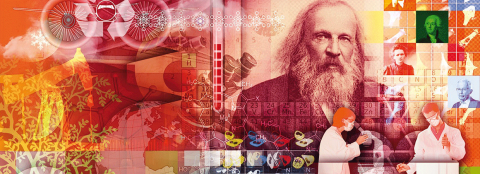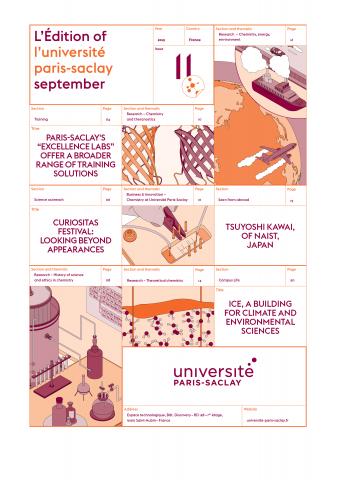NO to popular misconceptions in chemistry! (1/3)
At a time when climate, the environment and the protection of our planet are finally taking centre stage, Université Paris-Saclay...

At Université Paris-Saclay, we teach, practice and champion chemistry. And we are good at it, ranking no.1 in the field in Ile-de-France and no.2 in France after our colleagues in Strasbourg. Find out about us with an open mind.
Chemistry is a field of French scientific excellence, as demonstrated by no less than nine Nobel Prizes awarded to French chemists over the years.
It is also a leading business sector in France with a trade surplus of € 10bn, making it the country's top export industry. Unfortunately, as we all know, the industry gets a bad press, as the processes it uses are considered to be polluting and dangerous.
Yet we must keep teaching, developing and using chemistry, particularly in research and development.
Why? Because it is an area of strategic knowledge which is ahead of all the others. And because now more than ever, we need to develop sustainable processes. Without chemistry, there can be no electric batteries for our cars, mobile phones or wind turbines. Without chemistry, there can be no new energy processes, no medicines, no soil remediation, no green and healthy packaging, no medical breakthroughs and no new materials.
Chemistry at Université Paris-Saclay is steeped in the history of great pioneers, such as Marie Curie, Irène Joliot-Curie and Frédéric Joliot-Curie, who took up residence in Orsay at the end of the 1950s to develop ground-breaking research infrastructures. This tradition of excellence went hand-in-hand with a keen desire to apply their discoveries in chemistry, in particular the medical applications which gave their name to a cancer treatment establishment located in Paris, Saint-Cloud and Orsay, called the 'Institut Curie'.
Chemistry at Université Paris-Saclay was gradually extended to 24 laboratories, training a new generation of young researchers and research lecturers who have been developing these institutional resources over the past 10 years. As initiatives have been introduced, particularly the Investment Plan for the Future, our chemists have proved themselves by forging links and bridging disciplines. They have developed projects with research and training methods that combine a humanist and interdisciplinary approach and chemistry that is utterly dedicated to solving society's challenges.
In chemistry, Université Paris-Saclay currently boasts over a thousand permanent staff, in addition to no less than 500 doctoral students, at least as many post-doctoral students and 300 young scientists studying for their masters.
Together, this pool of young talent, experts, theoreticians, experiment specialists, engineers and technicians produce over 200 publications each year. The quality of the scientific output produced by these teams is matched by intense collaborative research in related fields, such as physics, pharmacy, health, etc., as well as with cutting-edge experimental platforms (MeetMyPlatform, PluginLabs).
The chemistry community is always open to industrial partners who are looking for new sources for raw materials, often from oceans, forests, plants, etc. They are also seeking practical applications and usage properties that are more relevant to current environmental issues, such as biodegradability or, at the other end of the spectrum, resistance to biological agents.
The (LabEx) CHARMMMAT laboratory of excellence was created around two internationally prominent fields that the southern Paris community particularly excels at, namely materials science and bio-inspired cascade catalysis.
CHARMMMAT brings together chemists, computer scientists and physicists from Université Paris-Saclay, in particular the Faculty of Sciences, ENS Paris-Saclay, CentraleSupélec, CEA, CNRS and the Universities of Versailles St-Quentin and Évry Val d'Essonne. The LabEx was also built in close scientific partnership with the chemistry department of the Ecole Polytechnique, despite the loosening of institutional ties in 2017.
Designed as an interface between Chemistry, Physics and Computer Science, this LabEx has had four main effects:
In the wider Paris-Saclay area, we have state-of-the-art experimental platforms, such as the SOLEIL synchrotron to see real-time performance, the Elyse accelerator to study elementary chemical and biochemical reactions in ultra-short time, the Clio infrared laser, the Imagif platform to image living organisms or the fusion mesocentre designed to increase High-Performance Computing capacities and share with researchers of other institutions and companies.
We must continue to invest in these infrastructures which have yielded results in the research field, as well as in terms of training to research and training through research.
In the future, the entire masters and doctoral training at Université Paris-Saclay will be taught in Graduate Schools, which are highly international colleges of higher education that train young professionals for academic and industrial careers. These resources will make it possible to anticipate future professions and to grasp the opportunities presented by the opening of research centres by leading French companies such as EDF, Danone, Air liquide, Safran, Servier, etc.
This match between the training we provide, the research that underpins it and the markets it addresses enables us to guarantee employment for our young Master's graduates who, at the end of their work placements in companies, government or industry associations, embark on careers related to analytical chemistry, the environment, pollution reversal, perfumes, cosmetics and food, etc.
The study of Chemistry was born of the need to control our environment and to make it serve mankind through controlling fire as an energy source, the first mineral extraction methods to produce alloys, pigments, medicinal compounds, the first transformations and mixtures to produce bitumens and building materials. Societies began and were developed through the use of wood, leather, hydrocarbons, oils and plant fibres. As fossil resources become scarcer, modern chemistry offers a strategic way to minimise the impacts of products and processes and discover how they can be substituted with renewable, biodegradable processes and raw materials that require less power to produce and generate less greenhouse gases.
The disruptive scientific advances upstream and downstream of chemical processes, from access to plant-based carbonaceous resources to their transformation by bio(chemo)technologies, suggest that eventually the products of this sustainable chemistry (renewable, substitutable and competitive) will replace those derived from fossil fuels in the fields of energy, well-being, perfumes, cosmetics, materials, fine chemicals, human and animal health products, etc.
The challenge for research teams like ours is to keep to the same scale, but for renewable products.

Teaching, learning: Paris-Saclay's "excellence labs" offer a borader range of training solutions
Science Outreach: CURIOSITas festival: looking beyond appearances
Research: Chemistry, tell me your story
Research: Reporter molecules lead the way in molecular labelling and detection
Business & Innovation: Chemistry at Université Paris-Saclay
Research: Modelling complex molecular systems
Research: Moving towards the substitution of oil with alternative energy
Campus life: ICE, a building for climate and environmental sciences
...
At a time when climate, the environment and the protection of our planet are finally taking centre stage, Université Paris-Saclay...
At a time when climate, the environment and the protection of our planet are finally taking centre stage, Université Paris-Saclay...
At a time when climate, the environment and the protection of our planet are finally taking centre stage, Université Paris-Saclay...
Thibault Cantat is a researcher at the CEA and a chemist specialising in the chemistry of metals and their use...
Philippe Dillmann is Head of Research at CNRS and has just received a silver medal. He is in charge of...
Ruxandra Gref is a research director at the Molecular Science Institute of Orsay (ISMO - Université Paris-Saclay, CNRS) and winner...
A chemist at the interface of biology, Jean-Pierre Mahy is a researcher at Orsay Institute of Molecular Chemistry and Materials...
Rachel Méallet-Renault is a physico-chemist, a researcher at the Orsay Institute of Molecular Sciences (ISMO - Université Paris-Saclay/Université Paris-Sud/CNRS), a...
Hynd Remita is a research director at the Laboratory of chemistry and physics (Laboratoire de chimie-physique, LCP - CNRS/Université Paris-Sud)...